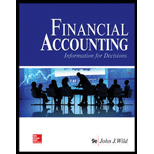
Loose Leaf for Financial Accounting: Information for Decisions
9th Edition
ISBN: 9781260158762
Author: John J Wild
Publisher: McGraw-Hill Education
expand_more
expand_more
format_list_bulleted
Question
Chapter B, Problem 1QS
Summary Introduction
Concept Introduction:
Future value is the value of present money after a period of time. Future value of present money is calculated using the interest rate and period. The present value of a sum is multiplied with the future value factor to get the future value.
To identify: the interest rate column and number of period.
Expert Solution & Answer
Explanation of Solution
| Rate | Interest rate | Number of period | |
| 12% annual rate, compounded annually | 12% | 1 | The compounding is annual, hence the rate shall remain same and period shall be 1. |
| 6% annual rate, compounded semiannually | 3% | 2 | The compounding is semiannual, hence the rate shall be half and period shall be double. |
| 8% annual rate, compounded quarterly | 2% | 4 | The compounding is quarterly, hence the rate shall be one fourth and period shall be four times. |
| 12% annual rate, compounded monthly | 1% | 12 | The compounding is monthly, hence the rate shall be divided by 12 and period shall be multiplied by 12. |
Want to see more full solutions like this?
Subscribe now to access step-by-step solutions to millions of textbook problems written by subject matter experts!
Students have asked these similar questions
If the project's cost of capital is 11%, what is the NPV of the project?
What is the Year-0 net cash flow?
$ -85,000
What are the net operating cash flows in Years 1, 2, and 3?
Year 1:
$25,403
Year 2:
$27,682
Year 3:
$21,606
I am searching for the correct answer to this general accounting problem with proper accounting rules.
Please explain the solution to this general accounting problem with accurate explanations.
Chapter B Solutions
Loose Leaf for Financial Accounting: Information for Decisions
Knowledge Booster
Similar questions
- I need help solving this general accounting question with the proper methodology.arrow_forwardCan you solve this general accounting problem using appropriate accounting principles?arrow_forwardPlease provide the correct answer to this general accounting problem using valid calculations.arrow_forward
- Stockholders' equity at the end of the year was ____.arrow_forwardI need the correct answer to this general accounting problem using the standard accounting approach.arrow_forwardThe installation of a ______ system will create confidence in the minds of public about the fairness of the prices charged. a. Costing b. Financial accounting c. Management accounting d. Informationarrow_forward
arrow_back_ios
SEE MORE QUESTIONS
arrow_forward_ios
Recommended textbooks for you

 EBK CONTEMPORARY FINANCIAL MANAGEMENTFinanceISBN:9781337514835Author:MOYERPublisher:CENGAGE LEARNING - CONSIGNMENT
EBK CONTEMPORARY FINANCIAL MANAGEMENTFinanceISBN:9781337514835Author:MOYERPublisher:CENGAGE LEARNING - CONSIGNMENT


EBK CONTEMPORARY FINANCIAL MANAGEMENT
Finance
ISBN:9781337514835
Author:MOYER
Publisher:CENGAGE LEARNING - CONSIGNMENT